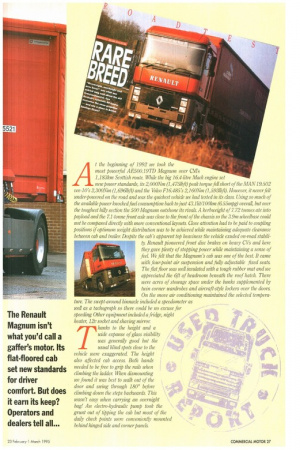A t the beginning of 1992 we took the most powerful
Page 29

If you've noticed an error in this article please click here to report it so we can fix it.
AE500.19TD Magnum over CM's 1,183km Scottish route. While the big 76.4-litre Mack engine set new Power standards, its 2,000Nm (1,4751bft) peak torque fell short of the MAN 19.502 vee-10's 2,3001Vm (1,6961bft) and the Volvo F76.485's 2,760111m (l ,5931bfl). However it never felt under-powered on the road and was the quickest vehicle we had tested in its class Using so much of the available power knocked fuel consumption back to just 43.11it/100km (655mpg) overall, but over the toughest hilly section the 500 Magnum outshone its rivals. A kerbweight of 772 tonnes ate into payload and the 7.1-tonne front axle was close to the front of the chassis so the 3.9m wheelbase could not be compared directly with more conventional layouts Close attention had to be paid to coupling positions if optimum weight distribution was to be achieved while maintaining adequate clearance between cab and trailer Despite the cab's apparent top heaviness the vehicle exuded on-road stability Renault Pioneered front disc brakes on heavy CVs and here they gave plenty of stopping power while maintaining a sense of feel. We felt that the Magnum's cab was one of the best. It came with four-point air suspension and fully adjustable fixed seats. The flat floor was well insulated with a tough rubber mat and we appreciated the 6ft of headroom beneath the roof hatch. There were acres of stowage space under the bunks supplemented by twin corner wardrobes and aircraft-style lockers over the doors. On the move air conditioning maintained the selected temperature. The swept-around binnacle included a speedometer as well as a tachograph so there could be no excuse for speeding Other equipment included a fridge, night heater, 12v socket and shaving mirror Thanks to the height and a wide expanse of glass visibility was generally good but the usual blind spots close to the vehicle were exaggerated The height also affected cab access. Both hands needed to be free to grip the rails when climbing the ladder When dismounting we found it was best to walk out of the door and swing through 180° before climbing down the steps backwards. This wasn't easy when carrying an overnight bag! An electro-hydraulic Pump took the grunt out of tipping the cab but most of the daily check points were conveniently mounted behind hinged side and corner panels.














































































































